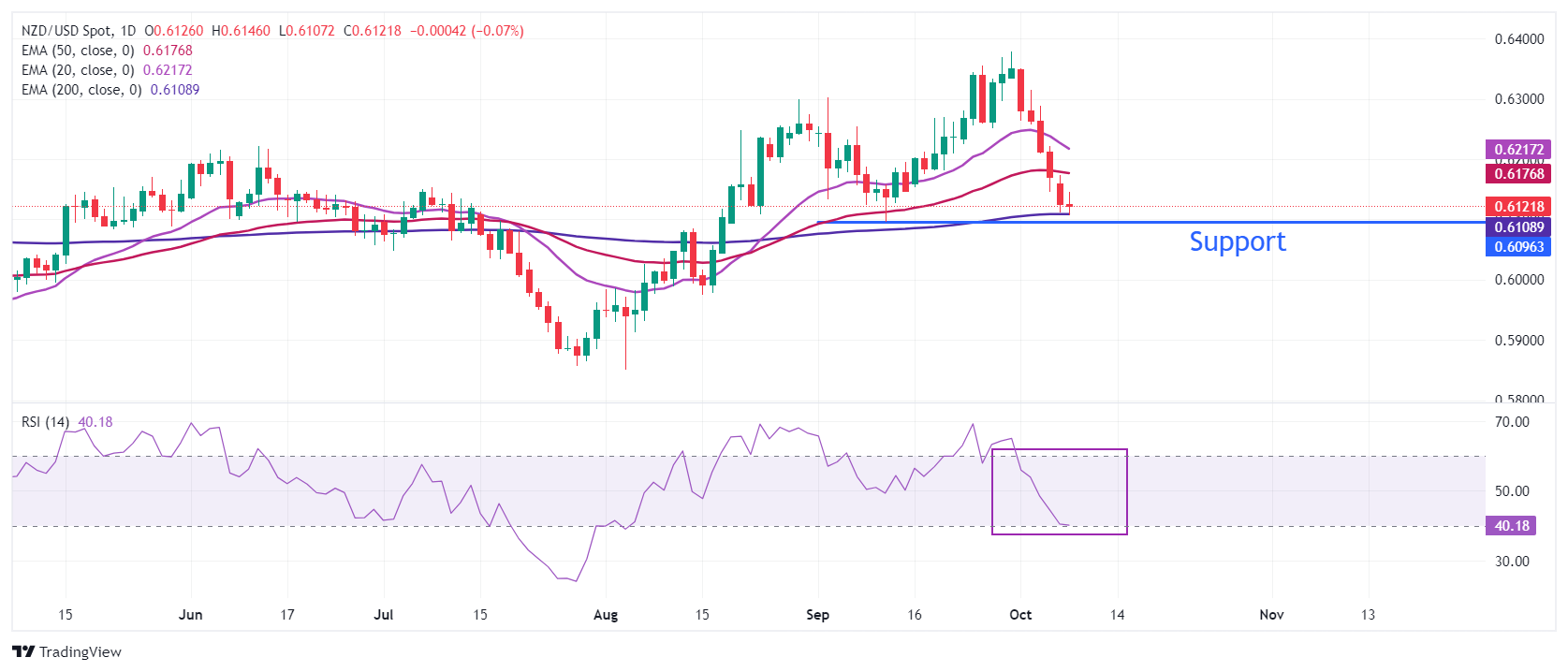- NZD/USD falls to a monthly low near 0.6100 as traders brace for the RBNZ’s policy decision.
- The RBNZ is expected to reduce its OCR further by 50 bps to 4.75%.
- Investors await the US inflation data for fresh guidance on the Fed’s interest rate outlook.
The NZD/USD pair hits the monthly low near the round-level support of 0.6100 in Tuesday’s North American session. The Kiwi pair weakens as the New Zealand Dollar (NZD) is under pressure ahead of the Reserve Bank of New Zealand’s (RBNZ) policy decision, which will be announced on Wednesday.
The RBNZ is expected to cut its Official Cash Rate (OCR) by a larger-than-usual size of 50 basis points (bps) to 4.75% as the central bank is focused on reviving economic growth. The board also reduced its borrowing rates unexpectedly by 25 bps in August.
Meanwhile, weakness in Chinese markets due to the unavailability of specific details for allocation of funds in the stimulus package of 200 billion yuan unveiled by Chairman of the National Development and Reform Commission (NDRC) Zheng Shanjie on Tuesday after the long National Day holiday has failed to prompt recovery in the Kiwi dollar.
On the United States (US) front, the US Dollar (USD) struggles to extend its upside, with investors focusing on the Consumer Price Index (CPI) data for September, which will be announced on Thursday. The inflation data will influence market expectations for the Federal Reserve’s (Fed) interest rate outlook for the remaining year. The core CPI – which excludes volatile food and energy prices – is estimated to have grown steadily by 3.2%.
NZD/USD extends its losing streak for the sixth trading session on Tuesday. The Kiwi pair has discovered temporary support near the 200-day Exponential Moving Average (EMA) around 0.6100.
The 14-day Relative Strength Index (RSI) has declined to near 40.00. A bearish momentum would trigger if the oscillator slips below the above-mentioned level.
More downside would appear if the pair breaks below the horizontal support plotted from September 11 low around 0.6100. The asset would decline further towards May 3 high of 0.6046 and the psychological support of 0.6000 if it breaks below September 11 low.
On the flip side, a reversal move above the 20-day EMA at 0.6230 will drive the asset towards September 3 high of 0.6302 and September 30 high near 0.6380.
NZD/USD daily chart
Economic Indicator
RBNZ Interest Rate Decision
The Reserve Bank of New Zealand (RBNZ) announces its interest rate decision after its seven scheduled annual policy meetings. If the RBNZ is hawkish and sees inflationary pressures rising, it raises the Official Cash Rate (OCR) to bring inflation down. This is positive for the New Zealand Dollar (NZD) since higher interest rates attract more capital inflows. Likewise, if it reaches the view that inflation is too low it lowers the OCR, which tends to weaken NZD.
Read more.Next release: Wed Oct 09, 2024 01:00
Frequency: Irregular
Consensus: 4.75%
Previous: 5.25%
Source: Reserve Bank of New Zealand
The Reserve Bank of New Zealand (RBNZ) holds monetary policy meetings seven times a year, announcing their decision on interest rates and the economic assessments that influenced their decision. The central bank offers clues on the economic outlook and future policy path, which are of high relevance for the NZD valuation. Positive economic developments and upbeat outlook could lead the RBNZ to tighten the policy by hiking interest rates, which tends to be NZD bullish. The policy announcements are usually followed by Governor Adrian Orr’s press conference.
Information on these pages contains forward-looking statements that involve risks and uncertainties. Markets and instruments profiled on this page are for informational purposes only and should not in any way come across as a recommendation to buy or sell in these assets. You should do your own thorough research before making any investment decisions. FXStreet does not in any way guarantee that this information is free from mistakes, errors, or material misstatements. It also does not guarantee that this information is of a timely nature. Investing in Open Markets involves a great deal of risk, including the loss of all or a portion of your investment, as well as emotional distress. All risks, losses and costs associated with investing, including total loss of principal, are your responsibility. The views and opinions expressed in this article are those of the authors and do not necessarily reflect the official policy or position of FXStreet nor its advertisers. The author will not be held responsible for information that is found at the end of links posted on this page.
If not otherwise explicitly mentioned in the body of the article, at the time of writing, the author has no position in any stock mentioned in this article and no business relationship with any company mentioned. The author has not received compensation for writing this article, other than from FXStreet.
FXStreet and the author do not provide personalized recommendations. The author makes no representations as to the accuracy, completeness, or suitability of this information. FXStreet and the author will not be liable for any errors, omissions or any losses, injuries or damages arising from this information and its display or use. Errors and omissions excepted.
The author and FXStreet are not registered investment advisors and nothing in this article is intended to be investment advice.
Recommended content
Editors’ Picks

EUR/USD clings to recovery gains near 1.0950 on US Dollar weakness
EUR/USD is holding onto recovery gains near 1.0850 in European trading on Tuesday amid a broadly weaker US Dollar. The recovery in risk sentiment undermines the havem demand for the US Dollar, lifting the pair. Dovish Fed expectations also weigh negatively on the Greenback. Tariff updates eyed.

GBP/USD pares back gains toward 1.2750
GBP/USD is paring back gains to revisit 1.2750 in Tuesday's European session. The pair draws support from renewed US Dollar weakness and a positive shift in risk sentiment but US President Trump's tariff war and global growth concerns limit its upside.

Gold bounces back above $3,000 as trade war tensions flair up
Gold price is bouncing higher in tandem with Equities after another stellar nosedive move on Monday. The precious metal trades just above the $3,000 mark at the time of writing on Tuesday. The bounce is supported by a technical element on the one hand and a geopolitical driver on the other.

XRP battles tariff turbulence amid MVRV buy signal
Ripple seeks stability in a volatile crypto landscape influenced by macroeconomic factors, including reciprocal tariffs. The international money transfer token hit a low of $1.64 on Monday after opening the week at $1.92, representing a 14.5% daily drop.

Strategic implications of “Liberation Day”
Liberation Day in the United States came with extremely protectionist and inward-looking tariff policy aimed at just about all U.S. trading partners. In this report, we outline some of the more strategic implications of Liberation Day and developments we will be paying close attention to going forward.

The Best brokers to trade EUR/USD
SPONSORED Discover the top brokers for trading EUR/USD in 2025. Our list features brokers with competitive spreads, fast execution, and powerful platforms. Whether you're a beginner or an expert, find the right partner to navigate the dynamic Forex market.




